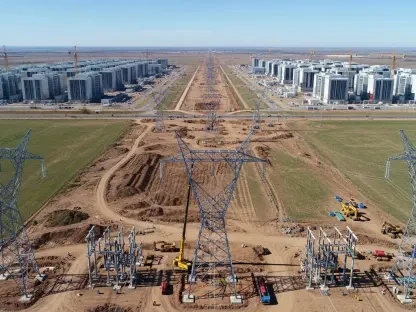Imagine a household where over 20 devices—from smart TVs streaming 8K content to gaming consoles and remote work laptops—run simultaneously without a hint of lag or buffering. This scenario, once a distant dream, is becoming a reality for Quebec residents as Rogers Communications rolls out WiFi 7 technology through its 5G Home Internet service. With household data usage skyrocketing by 200% over recent years, the demand for robust connectivity has never been more pressing. This roundup dives into diverse perspectives from industry analysts, technology experts, and consumer advocates to explore what this cutting-edge advancement means for Quebec homes, how it fits into broader digital trends, and whether it truly delivers on its promises.
Exploring the Promise of Next-Gen Connectivity
What Industry Analysts Are Saying About WiFi 7’s Arrival
Industry analysts have hailed Rogers’ deployment of WiFi 7 in Quebec as a pivotal step toward future-proofing home internet across Canada. Many point to the technology’s ability to deliver multi-gigabit speeds and ultra-low latency as a game-changer for data-intensive environments. One common observation is that this rollout, following a successful pilot in Calgary, positions Rogers at the forefront of wireless innovation in North America.
A differing view among analysts centers on the scalability of this technology. While the potential for supporting over 200 devices simultaneously—demonstrated by hardware like the Xfinity Pro 4G router in Calgary with speeds up to 4 Gbps—is impressive, some caution that Quebec’s implementation might face initial hiccups due to varying infrastructure readiness. The consensus leans toward optimism, though, with expectations that Rogers will refine its approach based on real-world feedback.
Another angle focuses on the competitive landscape. Analysts note that Rogers’ move pressures other providers to accelerate their own next-gen offerings, potentially sparking a wave of upgrades across the industry. This could benefit consumers with more choices, though there’s concern that smaller providers might struggle to keep pace with such rapid advancements.
Technology Experts Weigh In on Performance and Challenges
Technology experts are buzzing about WiFi 7’s technical capabilities, particularly its enhanced bandwidth and capacity to handle high-density device environments. Many emphasize that Quebec households using Rogers 5G Home Internet could see seamless connectivity for streaming, gaming, and smart home systems, even during peak usage times. The integration with 5G and Hybrid Fiber Coax (HFC) networks is often cited as a key strength, amplifying overall performance.
However, some tech specialists highlight potential obstacles in hardware distribution. Unlike Calgary, where advanced routers set a global benchmark, there’s uncertainty about whether Quebec will receive identical equipment or face delays in accessing top-tier devices. This discrepancy could impact early adopters’ experiences, though experts agree that Rogers’ track record suggests a commitment to resolving such gaps swiftly.
A third perspective from tech circles underscores the learning curve for consumers. While the technology promises plug-and-play simplicity, ensuring device compatibility and optimizing home setups might require additional support. Experts suggest that Rogers could mitigate this by offering detailed guides or dedicated customer service channels to ease the transition for less tech-savvy users.
Regional Impact and Broader Implications
Consumer Advocates on Bridging Digital Divides in Quebec
Consumer advocacy groups have expressed enthusiasm for how WiFi 7 could address connectivity disparities across Quebec’s diverse landscapes. Many argue that Rogers’ expansion, paired with its 5G infrastructure, offers a unique opportunity to enhance internet access in both urban hubs and rural areas. The potential for reliable streaming and remote work in underserved regions is seen as a significant step toward digital equity.
Yet, there’s a note of caution regarding rollout pacing. Advocates point out that rural communities might not see immediate benefits if infrastructure upgrades lag behind urban deployments. This uneven distribution could temporarily widen the digital gap before closing it, prompting calls for transparent timelines and prioritized investments in less-served areas.
Additionally, affordability remains a hot topic. While the technology’s benefits are clear, consumer representatives stress the importance of accessible pricing models to ensure that all households, regardless of income, can leverage these advancements. Some suggest that Rogers could partner with local initiatives to offer subsidized plans, making cutting-edge internet a reality for everyone.
Industry Trends and Future Outlook from Thought Leaders
Thought leaders in telecommunications view WiFi 7 as part of a larger wave of hybrid network solutions reshaping the industry. The fusion of WiFi 7 with Rogers’ 5G and HFC systems is frequently cited as evidence of a shift toward integrated, high-performance connectivity. Many predict that Quebec’s rollout will serve as a blueprint for expansions across Canada, with plans already in motion for additional regions later this year.
A contrasting opinion questions whether WiFi 7 is a revolutionary leap or merely an incremental upgrade. While acknowledging its superior speed and capacity, some leaders argue that its true impact depends on parallel innovations like 5G Advanced (5G-A) testing and network slicing, which Rogers is trialing in cities like Montreal. These complementary technologies could unlock even greater potential for tailored, efficient networks.
Beyond residential use, thought leaders highlight broader applications, such as dedicated network services for first responders. This holistic approach, blending consumer and specialized solutions, is seen as a defining feature of Rogers’ strategy, setting it apart from competitors who may focus narrowly on home internet. The discussion often circles back to adaptability—how well these systems can evolve with emerging needs over the coming years.
Practical Insights for Quebec Residents
Tips and Recommendations from Tech Reviewers
Tech reviewers have compiled actionable advice for Quebec households eager to embrace WiFi 7 through Rogers 5G Home Internet. A recurring tip is to assess current device compatibility, as older gadgets might not fully support the new standard’s capabilities. Reviewers often recommend investing in WiFi 7-certified routers or extenders once available to maximize speed and coverage within the home.
Another frequent suggestion is to stay informed about hardware rollouts. Since Quebec’s specific equipment details are not yet fully disclosed, keeping tabs on Rogers’ updates can help residents prepare for optimal setups. Some reviewers advise signing up for notifications or checking support resources to avoid missing out on early access to advanced devices.
Lastly, optimizing home network layouts is a common theme. Reviewers suggest placing routers centrally to minimize signal interference and testing connection speeds across different areas of the house. This hands-on approach, paired with Rogers’ customer support, can ensure that families experience the full benefits of low-latency, multi-device connectivity without unnecessary disruptions.
Balancing Hype and Reality: Mixed Consumer Feedback
Early feedback from consumers in regions with similar rollouts, like Calgary, offers a balanced view for Quebec residents to consider. Many users rave about the transformative impact of WiFi 7, citing flawless performance during heavy usage scenarios such as simultaneous 4K streaming and online gaming. Positive reviews often emphasize the relief of no longer battling dropped connections or sluggish speeds.
On the flip side, some consumers report initial challenges, particularly with setup and compatibility. Complaints include older devices struggling to connect or not achieving advertised speeds without upgraded hardware. These mixed experiences suggest that while the technology holds immense promise, individual outcomes may vary based on specific household needs and equipment.
A third stream of feedback focuses on customer service interactions. Users who proactively sought guidance from providers found the transition smoother, highlighting the value of accessible support. For Quebec residents, this underscores the importance of engaging with Rogers’ resources early on to navigate potential hurdles and fully capitalize on the upgrade.
Reflecting on a Milestone in Canadian Connectivity
Looking back, the introduction of WiFi 7 to Quebec by Rogers Communications marked a significant moment in the evolution of home internet across Canada. The diverse insights gathered from analysts, experts, advocates, and consumers painted a multifaceted picture of innovation, opportunity, and cautious optimism. As this technology took root, it became clear that its success hinged not just on speed and capacity, but on equitable access and robust support systems. For those in Quebec and beyond, the next steps involved staying proactive—evaluating personal connectivity needs, exploring available resources from Rogers, and keeping an eye on further expansions and upgrades. This rollout laid a foundation for smarter, more adaptable networks, inviting Canadian households to envision and shape the digital landscape of tomorrow.









